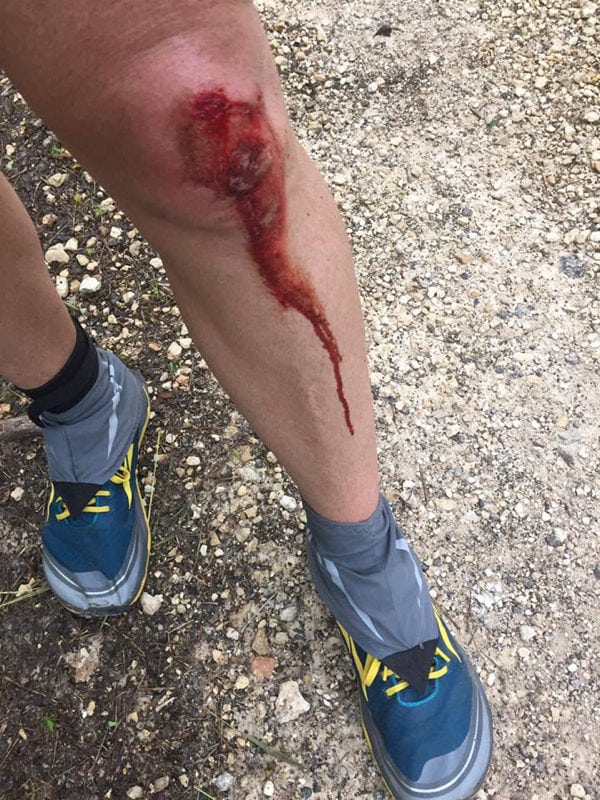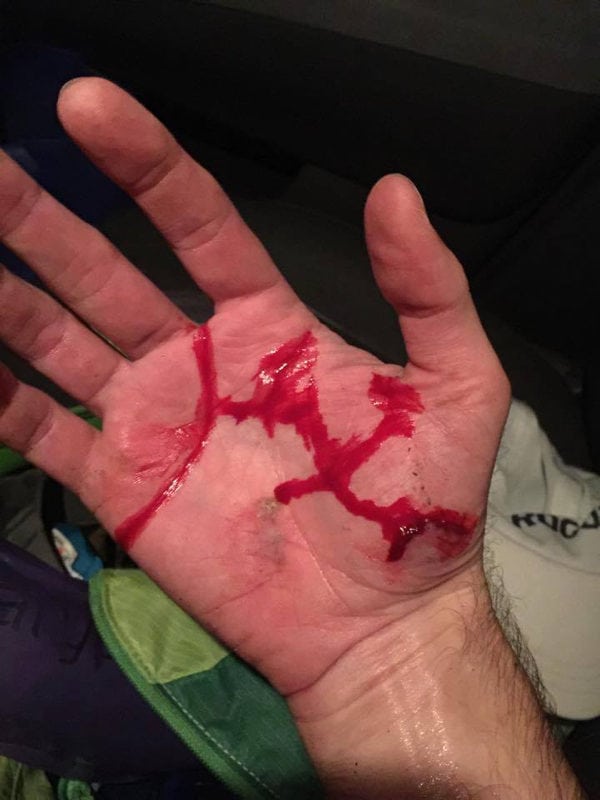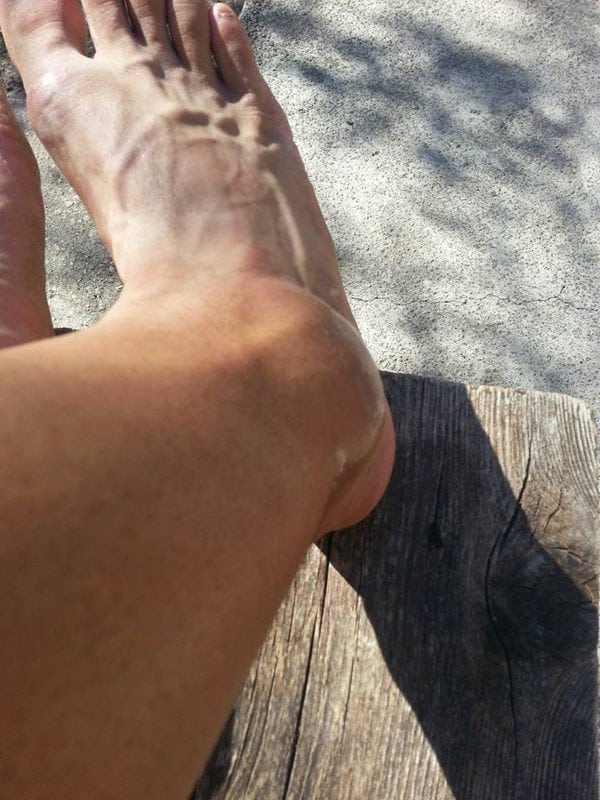From Pam:
Runners head to the trails to get away from life’s problems and to escape from the responsibilities of modern life. But trail running can present some problems of its own, particularly if one gets a little too carefree when heading out into nature. Many of the problems in trail running stem from poor preparation or safeguards against the most common problems. But other issues can arise–such as injuries or animal encounters–and it behooves you to have some general knowledge of what to do in these situations.
As the saying goes, “an ounce of prevention is worth a pound of cure.” The most common things that happen to trail runners are getting lost, getting stuck out in bad weather, and not having enough food and water. All of these problems can be mitigated or avoided by bringing a few basic items. And while this may seem like beginner-level advice, I’ve heard countless stories from very experienced runners who have run into trouble by being under-prepared.
Just recently, a friend of mine who was crewing at Western States set out for what she thought was an easy eight-mile run on some unfamiliar trails at Squaw Valley, California without any food or water. She ran into deep snow at high elevations and had to retrace her steps, turning her eight-mile run into 12. To make matters worse, it was a lot hotter than she expected. By the time she was finished, she was severely dehydrated and laid up all afternoon from exhaustion and vomiting.
Earlier this spring, I went for a run with some friends in nearby McDonald Forest, a place where we all knew the trails well. Or, at least we knew the trails we always run on well! When the main connector road was impassable due to logging, we decided to take a spur that none of us had ever done before. It turns out the road did NOT go where a few people assumed it did, and we ended up in a valley on the wrong side of the mountain 18 miles into a planned 20-mile run and still at least 12 miles from the car. To make matters worse, it had started to pour and none of us had jackets. Fortunately, one person knew someone who lived nearby and we sheepishly knocked on the door and got a ride back to our cars!
If you aren’t super familiar with the trails you are on, you should bring a map. I like to print maps that I find online and put them in a plastic Ziploc in my pack. This takes minimal investment on my part, but ensures that I’ll have a reference to double check when I come to a junction. For most trail systems a simple printout is sufficient, but if you are headed out into more remote areas, it is a good idea to pick up a topographic map of the area and learn how to use a compass.
Always bring more food and water than you think you’ll need. Even if you don’t get lost, trail conditions can make things a lot slower than you expect, natural water sources can be unreliable, or the weather conditions can make you need more than usual. I find I like to eat more than usual when it is cold and I drink more than usual when it is hot. Plan accordingly. Two or three hundred extra calories only weighs a couple ounces, but it may prevent that bonk when you are the most desperate! Similarly, there are many lightweight jackets and rain shells that weigh only a couple ounces and fit in a small pocket. Weather in the mountains can change quickly, even if it looks like a beautiful bluebird day.
Despite the best preparations, things can still go wrong–usually in the form of an injury. Fortunately, we have Liza on our team, an instructor for the Wilderness Medicine Institute and the National Outdoor Leadership School, to help us out here!
From Liza:
Okay, I’ve got to break the fourth wall à la Harvey Korman for a moment. Pam writes so well, and is always on point, and when she sent me what she’d written this month, I just couldn’t come up with anything to add besides: You all should go take a 16-hour Wilderness First Aid course.
The truth is, while I’ve run and worked in the mountains and other wild places, I’ve spent the majority of the last 10 years running trails in San Antonio, Texas. Our trails are beautiful and plentiful, but they don’t lend themselves to memorable trail-safety stories. Our snakes are disinterested, and while you can get lost for a while, it’s impossible to stay lost. Certainly heat emergencies are a safety hazard here, but the heat is really the last thing to inspire memorable writing at the end of July in Texas.
I decided to circle my neighborhood until I came up with a good angle–or a story that might drive home an important point, or at least something amusing. It was 9:30 p.m., and the Fiesta Texas fireworks were reaching their climax. (I always pretend the fireworks are celebrating my decision to run. Nice job, Liza!) But six miles of slow looping didn’t help, and I’d started to despair. My two year-old gets up at 5 a.m, and she frowns on computer time for anyone but herself.
Then the giant raccoon rushed out from behind a garbage can. It froze when it saw me and stared with his big glowing eyes. I could smell the rabies on its breath. I turned, sprinted down the road, up my driveway, tripped, twisted my ankle, skinned my knee, and sliced my finger open. I got up and hobbled into the house… inspired.
So, listen, you really should take a 16-hour Wilderness First Aid (WFA) course. It’s the best investment after shoes and running socks you’ll make as a trail runner. ‘Cuz chances are you’re going to get hurt.

Photo: Brian Austin four miles into a 50 miler
Or your good friend is going to get hurt.

Photo: Eric Jenkins after tripping and landing on his hand. The avulsion got infected.
Or some nice stranger is going to get hurt.

Photo: Alan Velazco after slipping on a root on trails in Grapevine, Texas.
[Editor’s Note: The Trail Sisters have provided two more images of more severe trail injuries. Click to the links provided here to view them but be forewarned that they are graphic. Both individuals recovered. This head-injury image is of Kevin Jones after a fall running along the bluffs in Carlsbad, California. This finger-injury image is from John Fritchey after he fell and rolled over his hand at a trail race in Kansas.]
And it will happen somewhere along a trail where help won’t be quick in coming–somewhere you won’t be able to just walk into your house, call it a day, and lie on the couch with a bag of frozen peas on your ankle watching this season’s Salomon Running TV videos.
And what you’re able to do at the scene can be critical. As valuable as the first-aid skills you’ll learn on a these short courses are (taping rolled ankles, supporting twisted knees, wound care, and more), WFA’s also teach a system for gathering information. You can’t make good decisions or exercise good judgment without good information.
The runner you’re pacing runs into a low-hanging tree branch, gets knocked down, and sees black for a few eye blinks. Should they keep running if they feel up to it? Should they seek medical attention later? Should they seek it now?
Your friend comes into the Twin Lakes aid station at the Leadville 100 Mile. She’s complaining of a splitting headache, nausea, and lightheadedness. Should she continue up and over 12,600-foot Hope Pass? What if she’s coughing a bit?
You stumble into a cactus and one-inch spine punctures your calf. How do you clean the wound so it doesn’t get infected?
Snake bites, allergic reactions, blisters, hyponatremia, immersion foot… It’s wonderful to have skills and knowledge that allow you to help other people–especially other people who are runners. Wilderness First Aid training puts you in that position. And if you’re running or racing in remote wilderness areas, and you don’t have these basic skills…well, I think you should get them.
Three of the most widely recognized organizations in the United States that offer wilderness medicine training are: The Wilderness Medicine Institute (WMI), Wilderness Medical Associates (WMA), and Stonehearth Open Learning Opportunities (SOLO). A Wilderness First Aid course is 16 hours long and taught over two days–and it’s more fun than any standard first-aid class you’ve ever taken. Prices vary, but are often in the $200 range. There are also some wonderful resources WMI has online and a great free app you can use to record information. Please let me know if you have any questions (or want to share scary raccoon stories.)
From Gina:
I have to say, Pam and Liza have nailed just about everything I could have suggested. Map, extra food and water, lightweight rain shell, and a course in wilderness first aid, but the one thing that I would like to add is the simple task of telling a friend or loved one where you plan on running and an approximate time you will return. Sure, your plans may change a bit when you are out on the trail, but alerting someone to your proposed route or trailhead can be a life saver.
A friend of mine from Carbondale, Colorado–let’s call him ‘Ted’–went for what he thought would be a 10-mile run in the Maroon Bells-Snowmass Wilderness. He wanted to link up a few trails but would need to do some bushwhacking to connect them. Ted told me he’d be out for approximately two to 2.5 hours. Four hours rolled by along with a nasty storm and I hadn’t heard from him. We planned on grabbing a bite after his effort, so I was expecting his call. Five hours went by and I was now worried that something had gone wrong. With knots of worry in my stomach, I hopped in my car and drove to the trailhead from which Ted was starting. Sure enough, his car was still in the parking lot. I brought some extra food, water, and an extra rain jacket since it had just stormed (and since they weigh next to nothing). I ran for about five miles following his route and found the area he had planned to bushwhack. I made my way through the brush and up to the scree field where Ted planned on trekking. About 30 minutes in, I heard him yelling my name. I looked up the scree field and about a quarter of the way down from the top was Ted curled up in a ball, drenched, and shivering. He severely rolled his ankle and was forced to take cover (the best he could) during the storm. By the time the storm passed, his ankle was so swollen that he was practically crawling down the scree field.
I worked my way up to Ted, and gave him the jacket, food, and water. We decided to wrap his ankle with my Buff to provide it with some support, and then made our way down the scree field and eventually back to the car.
Since Ted had alerted me to his route I was able to find him and provide help. A few more hours out would have put him in the chilly temps of the nighttime mountain air. He easily could have become hypothermic, which would have led to larger problems, and even possible death. So, always, always, always, tell someone where you are going!
From Liza:
The most unsafe I’ve probably ever been on a trail run was coming off Mount Elbert in Colorado in a lightning storm. I’d hiked up there to do some acclimatization before the Leadville 100. I’d started later than I’d planned, and it had taken me a bit longer than I thought it would, and low black clouds moved in quickly over the summit while I was eating a PB&J sandwich. I packed up and was halfway to treeline when the thunder started. Lightning followed quickly. Then hail.
And still more thunder. I sprinted, eyes on treeline, thinking about how no one would feel sorry for me if I got hit by lightning running off the top of Mount Elbert in a storm. “Well, of course she got struck by lightning. Why didn’t she descend earlier? It’s not like afternoon thunderstorms are a surprise in the Colorado mountains.” And I knew better. I’d just really wanted the time up high before the race. Flashes of lightning followed me into the trees and kept me moving fast for another 15 minutes–long enough to be sore the following day.
I sat in my car afterward, relieved my family wouldn’t have to apologize for my stupidity to a search-and-rescue team.
The whole thing was such a tired example of letting a plan or an important goal or time pressure supersede thoughtful hazard evaluation and decision making. I promised myself I’d think about setting turnaround times before I headed out on a run in the mountains in the future–when thunderstorms were likely.
From Pam:
Most trail runners have a good story of something gone wrong or disaster nearly averted. When you are on a trail there are plenty of things to trip you up, both literally and figuratively. A little extra forethought and some basic first-aid training will go a long way to help you battle all the ‘trail trolls’ that might be there to thwart a great run.
From Liza:
Or at least give them the finger. ;)
Call for Comments (from Meghan)
- What is your ‘close-call’ story, where you took a tumble, came across an accident on the trail, got stuck out in storms, or temporarily lost your way?
- More importantly, can you articulate the lessons you learned from your close call and what you regularly do differently now to prevent something similar from happening again in the future?
